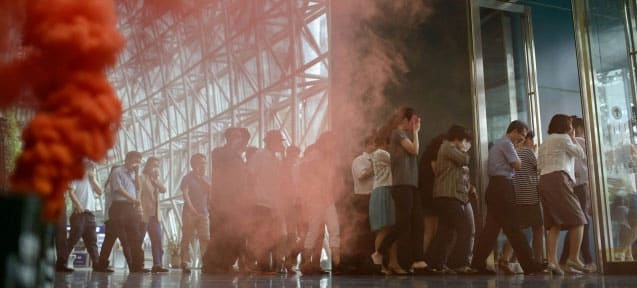What is fire evacuation training?
Fire evacuation training is an essential part of corporate safety. It provides the skills needed to organize and lead an evacuation in the event of fire. This includes mastering safety rules, identifying anomalies that could hinder evacuation, and handling fire extinguishers correctly. Regulations require evacuation drills to be carried out at least every six months. So this training is more than just an option - it's an obligation to ensure everyone's safety.
Principles of fire evacuation training
Fire evacuation training relies on several key elements to ensure a rapid and safe evacuation. It is essential to integrate the roles of each participant, such as the fire warden and fire guide, who supervise and direct the flow of evacuees.
Regular drills familiarize employees with the evacuation plan and reinforce their reflexes. They need to know how to identify emergency exits and assembly points.
In addition, good training includes learning communication techniques to coordinate evacuation and maintain calm. For example, a trained employee will be able to manage a panic situation and ensure the safety of his or her colleagues.
It's also important to take account of the building's specific features, and adapt procedures to suit them.
Fire evacuation regulations
Companies must comply with strict obligations regarding fire evacuation, as defined by the French Labor Code. Article R4227-39 stipulates that evacuation drills must be organized at least twice a year. These drills test the effectiveness of evacuation procedures and familiarize employees with the actions to be taken.
Facility managers are responsible for training their staff to react quickly in the event of a fire. This means knowing the alarm signal, exit routes and assembly points. It is also essential that employees know how to use first-response equipment such as fire extinguishers.
For example, a well-trained employee will be able to direct colleagues to the emergency exits without panicking, and ensure their safety until help arrives. Efficient evacuation is therefore a priority for reducing the risks in the event of fire.
Training validity: renewal and frequency of exercises
To guarantee the effectiveness of fire evacuation training, it's crucial to renew it regularly. In general, companies organize evacuation drills every six months. This ensures that employees' skills are kept up to date, and tests the effectiveness of the procedures put in place.
Fire extinguisher training is generally renewed every two to three years, depending on the specific risks faced by the company. It is essential to adapt to the needs of the facility, and to respond to any changes in personnel or structure.
New recruits need to be trained quickly to ensure their safety and that of others. By following these practices, companies ensure compliance with regulations while guaranteeing employee safety in the face of fire hazards.
The important role of the thread clamp and thread guide
The roles of the fire warden and fire guide are essential to ensure safe and efficient evacuation in the event of a fire. The guide is responsible for directing occupants to the emergency exits and to the assembly point. He or she must maintain composure to avoid panic and ensure that everyone follows established procedures.
As for the line-keeper, he closes the line and makes sure no one is left behind. He or she inspects every room to make sure everyone has left the premises. This tandem is vital to preventing accidents and ensuring everyone's safety.
Smooth communication between the guide and the booker is essential. For example, if a person with reduced mobility is present, they must coordinate their assistance to ensure a smooth evacuation. Their specific training enables them to act quickly, limiting the risk of loss of life.
Using an extinguisher for fire evacuation
When a fire breaks out, the correct use of an extinguisher is crucial to safety. Extinguishers must be easily accessible and their location well known to employees. To handle an extinguisher effectively, it's essential to know the type of fire you're dealing with:
- Class A fire: solid materials such as wood or paper, requiring a water or powder extinguisher.
- Class B fire: flammable liquids, where foam or CO2 extinguishers are recommended.
During an evacuation, it is advisable to attempt to extinguish the fire only if it can be done safely. If the fire is too large, prioritize evacuation and alert the emergency services. Here's a concrete example: in the event of a garbage can fire, a dry powder extinguisher can be used to quickly bring the flames under control, allowing safe passage for evacuation.
The company's fire safety obligations
To ensure fire safety, a company must commit to training its employees in fire-related risks. This training includes several essential aspects:
- Inform staff and make them aware of safety instructions.
- Installation and maintenance of extinguishing equipment.
- Organize regular evacuation drills, at least twice a year, to test the effectiveness of procedures.
In addition, companies with over 50 employees or handling flammable materials are required to draw up fire safety instructions. It is crucial to designate persons in charge, such as first-response team members, to ensure rapid response.
A concrete example: in a company handling chemical products, specific training in the use of appropriate extinguishers would be necessary to guarantee an effective response in the event of an incident.
Fire risk prevention: the trainer's role and responsibilities
Fire risk prevention trainers play a key role in ensuring safety in the workplace. He or she transmits the essential knowledge needed to prevent fires from starting and to react effectively in the event of an emergency. They must master teaching techniques to adapt to the specific needs of trainees.
Its expertise is multi-faceted:
- Train employees to handle extinguishing equipment.
- Teaching good evacuation practices.
A competent trainer knows how to adapt his methods to the configuration of the building and its particularities. For example, he can organize realistic scenarios to simulate a fire outbreak and train participants to evacuate quickly.
In this way, it helps to reinforce the safety culture within the organization, reducing the risks in the event of an incident.



